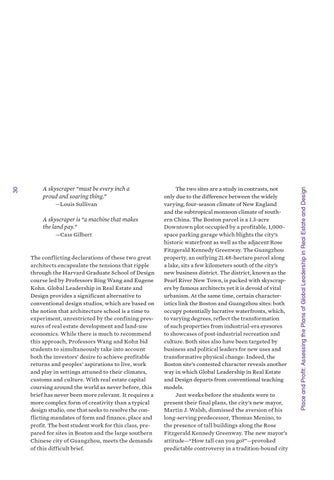A skyscraper is “a machine that makes the land pay.” —Cass Gilbert
The conflicting declarations of these two great architects encapsulate the tensions that ripple through the Harvard Graduate School of Design course led by Professors Bing Wang and Eugene Kohn. Global Leadership in Real Estate and Design provides a significant alternative to conventional design studios, which are based on the notion that architecture school is a time to experiment, unrestricted by the confining pressures of real estate development and land-use economics. While there is much to recommend this approach, Professors Wang and Kohn bid students to simultaneously take into account both the investors’ desire to achieve profitable returns and peoples’ aspirations to live, work and play in settings attuned to their climates, customs and culture. With real estate capital coursing around the world as never before, this brief has never been more relevant. It requires a more complex form of creativity than a typical design studio, one that seeks to resolve the conflicting mandates of form and finance, place and profit. The best student work for this class, prepared for sites in Boston and the large southern Chinese city of Guangzhou, meets the demands of this difficult brief.
The two sites are a study in contrasts, not only due to the difference between the widely varying, four-season climate of New England and the subtropical monsoon climate of southern China. The Boston parcel is a 1.3-acre Downtown plot occupied by a profitable, 1,000space parking garage which blights the city’s historic waterfront as well as the adjacent Rose Fitzgerald Kennedy Greenway. The Guangzhou property, an outlying 21.48-hectare parcel along a lake, sits a few kilometers south of the city’s new business district. The district, known as the Pearl River New Town, is packed with skyscrapers by famous architects yet it is devoid of vital urbanism. At the same time, certain characteristics link the Boston and Guangzhou sites: both occupy potentially lucrative waterfronts, which, to varying degrees, reflect the transformation of such properties from industrial-era eyesores to showcases of post-industrial recreation and culture. Both sites also have been targeted by business and political leaders for new uses and transformative physical change. Indeed, the Boston site’s contested character reveals another way in which Global Leadership in Real Estate and Design departs from conventional teaching models. Just weeks before the students were to present their final plans, the city’s new mayor, Martin J. Walsh, dismissed the aversion of his long-serving predecessor, Thomas Menino, to the presence of tall buildings along the Rose Fitzgerald Kennedy Greenway. The new mayor’s attitude—“How tall can you go?”—provoked predictable controversy in a tradition-bound city
Place and Profit: Assessing the Plans of Global Leadership in Real Estate and Design
30
A skyscraper “must be every inch a proud and soaring thing.” —Louis Sullivan
